We decided to spend our luxurious three week 2019 Christmas break in Sri Lanka. I had been there years before in about 2000 but not since. I remember the great birds, some great sites but terrible food. On that trip there was a week long part on the beach but this time we did no such thing travelling around the whole time. Like with our trip to Laos we probably packed a bit too much in but thoroughly enjoyed it regardless.
When we woke up for our first full day in a stop over hotel in Nogombo we found it to be delightful. Walking around we were greeted immediately by a 1958 Morris Minor and 2 Spot-billed Pelicans flying overhead – good omens if ever I saw them. Situated right on a large lagoon the grounds were teeming with bird life and 2 rather spoilt looking cats. Breakfast was excellent and our driver arrived promptly to drive us to the next hotel Horathapola Estate.
This hotel was simply glorious set in a 50 acre organic coconut plantation with lovely rooms and fantastic food. The birds were everywhere with a staff member handily pointing out a Sri Lankan grey-headed hornbill, one of their endemic species, and one new to my list. Other than the food, the highlight was sitting on the balcony and Lindsey experiencing for the first time the enormous fruit bats flying over with slow, crow like, wing beats.
The next day we were met by the driver who was with us for the rest of the trip, Asanka. He is a keen birder which was immediately evident as we starting stopping for the birds. He told us the trip up North towards Anuradhapura would take around 2.5 – 3 hours but it took 5 – oops! We did however see 31 different species taking me perilously close to 1,000 birds on my life list (992). The highlights were seeing several mongoose (Ruddy Mongoose) who are oddly tame although I suspect this is because, as eaters of snakes, they are not afraid of anything.
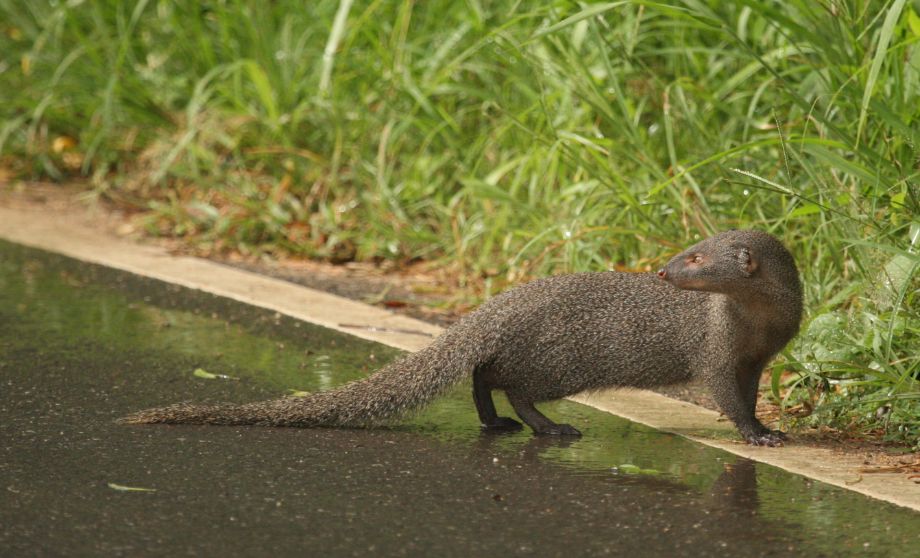
The hotel was called the Forest Rock Garden Resort. Our travel operator, didn’t really recommend it but didn’t have anything else in the area. They have made a fake Sri Lankan temple ruin out of cement complete with walkways and an ancient style swimming pool. It’s a bit tacky to be honest but perfectly serviceable and does have macaques hanging around as well as a random cat who we named Hannah short for Hannibal after she caught and ate a huge insect.
The next day’s itinerary were the major sites of Anuradhapura which was the first capital of Sri Lanka. Our first stop was Mihintale which is where the King of Sri Lanka was converted to Buddhism and where they subsequently built some stupas and a large Buddha. You can climb up the rock where the Buddhist monk was sitting with the help of a handrail but despite the rail it was still pretty hairy in places. Next stop was Jethawanaramaya Stupa which is the 3rd largest stupa in the world after the great pyramids in Egypt. The Indians came and took down the top of it and the plaster off when they started destroying Buddhist symbols but the bulk of it is still there and very impressive. Then we drove to another stupa, Ruwanwelisaya, built originally in 140 BC, all plastered and white which apparently gets repainted every 6 months. It is supported by a row of 344 elephants. Next on the list was a visit to the oldest living tree in the world, the sacred bodhi tree, with a branch supposedly grafted from the original tree the Buddha sat under. I was skeptical to say the least but we subsequently read that it is indeed the oldest authenticated living tree in the world. They had an original stone of the wall that was built to protect the tree (from elephants) protected under glass which the guide wanted to show us only a cat had somehow managed to get under the glass and was asleep in the nice sun trap!
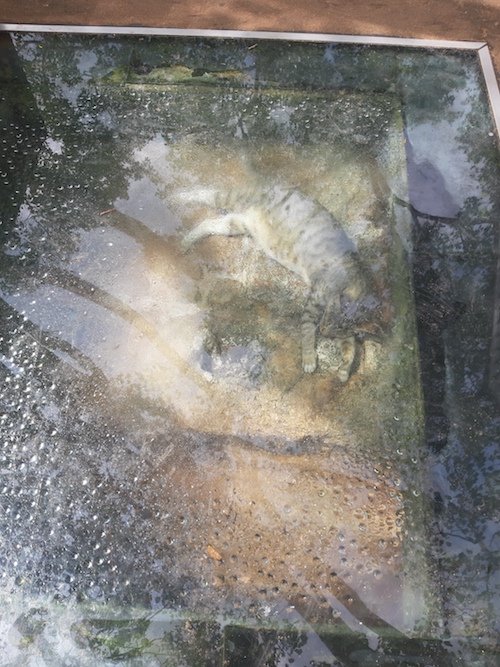
On the way to the tree we passed by a group of Black-faced Langur Monkeys which were actually quite aggressive and did a good job of scaring the mainly local tourists. Next up some twin ponds for the monks to bathe in ingeniously fed by lake water and filtered as well as drained. Not bad for the 2nd century BC!
Finally on to the moon stone which is a carved semi-circle of stone depicting the various stages of life before nirvana. On the way back we saw Lesser Whistling Ducks (994). Back at the Forest Rock Garden Resort, Lindsey took a dip in the recreated folly of a swimming pool and when we got back to our room we could see real damage done presumably by the Langur Monkeys hanging around. They had knocked over our heavy wooden chairs breaking one of them and upset the table top.
The next day, when we had breakfast we were preyed upon by the macaques such that when one of us went to the loo they would jump you grabbing from the other one’s plate. This happened both times when each one of us went to the loo.
Our next place was called the Mud House made up of several houses indeed made of mud and wood with a grass/bamboo thatch. It is completely open to the elements at the back but the beds have mosquito nets. For some reason there are very few mosquitos here despite being next to the water. Water, was then the theme for the afternoon as it continued to pour down for the rest of the day with a brief interval during which time we went for a walk around the grounds with a staff member as a guide. The grounds are lovely and I immediately chalked up a few more birds and caught a glimpse of a mouse deer.
Our time at the Mud House was great although the guiding was a little poor. The breakfast was particularly good. They have this thing called a hopper which is a kind of pancake with a fried egg in the middle which you eat with dahl and other types of curry – delicious. On the way to dinner once, we saw some sleeping birds and then I spotted two reflecting eyes further back in the trees. This turned out to be a slender lori which was great to see. After dinner we did a night walk to look for more loris. We did see several mouse deer and a hare but no more loris.
In our hut there were several bean bags around a low table. That night we awoke to a noise of something decidedly on the bean bags. We put on a torch from one of our phones hoping for a mongoose or a snake but only to discover that two of the camp dogs had decided this was a good place to sleep! They ran off at being discovered but were soon back to enjoy the rest of the night.
A little irked by the guiding, the next day we decided to go to a bird sanctuary wetland about an hour’s drive away with our guide. The was the Anawilundawa Ramsar Wetland. We got there a little late for ideal bird watching but did manage to get a few new birds for the Sri Lanka list. The place was really nice though and had a lovely tree lined (so shaded) path. Back at the Mud House that afternoon we were accosted by one of the other guides, a pretty doddery looking fellow with fairly broken English but insisted he take us on a bird watching walk. I was fairly sure I had reached the magical 1,000 birds on my e-bird database but when I added all the birds I’d seen I was only at 998 – 2 more to go. On our bird watching walk we stopped as I saw something I thought was a bird I’d already seen. It took a while to point it out to the guide as his eyes were clearly a bit rubbish but eventually he saw it and declared it a Jacobin or Pied Cuckoo, number 999. Ten minutes later or so a beautiful, rusty red bird flew up and landed in a spot where I could just about get a few photos. This turned out to be the Lesser Cuckoo – a great bird for my 1,000th! While I was furiously working on my photos and doing a Facebook post to celebrate the milestone, Lindsey walked back to our hut and stunningly saw a Jungle Cat! The staff here were a bit surprised to be honest and no other witnesses….just saying.
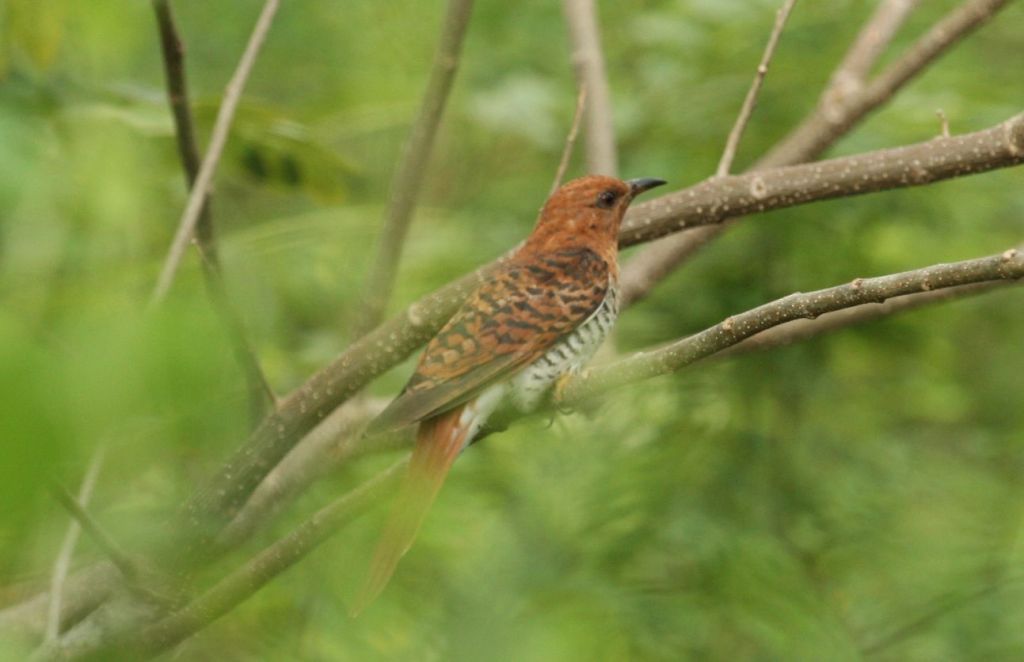
Next up Wilpattu National Park staying at Leopard Trails Camp with a guide who turned out to be exactly what we like in guides. Not too chatty but a real expert on birds and other wildlife. Leopard Trails has permanent tents which were well fitted out with luxuries like electricity and hot water.
Wilpattu is mainly a forest with roads cut into it but there are also quite a few open spaces as well as lakes. Immediately as we entered the park we started seeing wildlife like spotted deer and large birds of prey right next to the road. On this trip we also saw 2 the types of deer (Samba and Barking) as well as Water Buffalo, black-naped Hares and lots of Mongooses and Monitor Lizards. It was great to be back on safari despite not seeing any of the big stuff first time out.
The next day (Christmas Eve) we did a full day safari having both a packed breakfast and lunch. The highlights were seeing 2 leopards. We got word of the first one and proceeded to head off at dangerous speeds to get to it only to find it a load of other vehicles also there and the leopard itself was quite far away. You could see it fairly well with binoculars. There is little or no mobile signal in the park so the drivers cannot text each other if there is a sighting. That played into our hands beautifully for the second leopard as there was initially only one other vehicle there and then only 1 more joined us. This leopard was resting in a tree and we had a good view of it for maybe half an hour before it left.
Another full day of safari followed and this time as well as 2 more leopards we also saw an elephant, our first wild Asian Elephant! Christmas lunch was brought out to us in the park with tables and chairs all set out in true safari fashion – very nice.
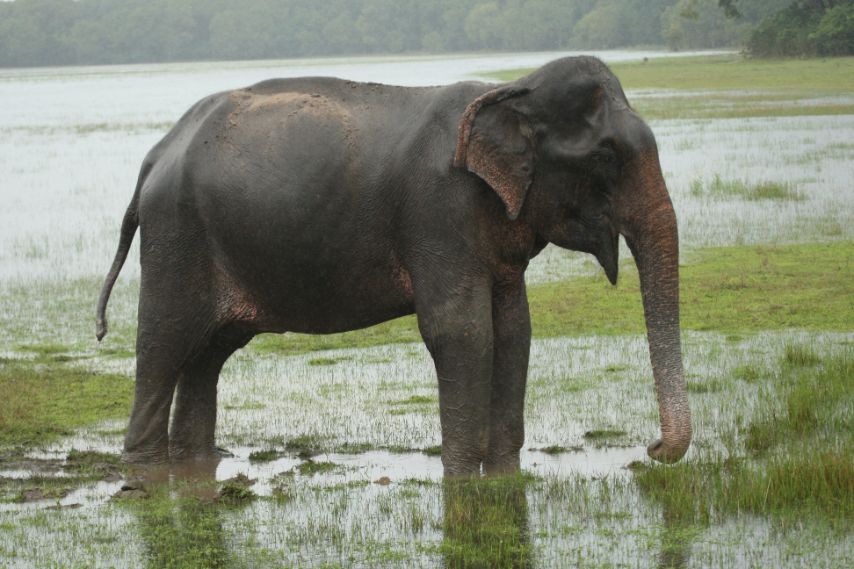
Next up Sigiriya which is the ruins of a palace built on a massive rock sticking up from the otherwise flat landscape. It was a bit more built up than I remember and much more crowded, although the crowds were almost entirely local, this time being a school holiday. There were very few Western Tourists which is a sign of the slowly recovering tourist industry following the terrorist attacks in April. It was as impressive as I remembered though with amazing frescoes still in good condition in places and quite a bit of the palace still visible.
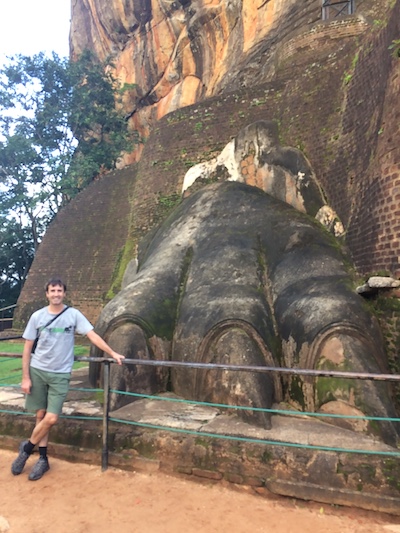
The next day we drove to Pollonnaruwa which was the second capital of Sri Lanka and was moved further South to better safeguard against invasions from India. There was an option to tour the sites by bike which sounds quite nice until you take into account the heat. Our guide dissuaded us from the activity and instead drove us around the sites himself acting as our guide. Some of the temples had quite a bit left with even a bit of renovation done here and there but no where near to the Gav levels I would do. One highlight was seeing a Coppersmith Barbet making a hole in a tree and posing for some good photos.
After visiting the sites our driver took us to a special lunch place. This was kind of a local place but also clearly for tourists. There were something like 20 curries laid out on a huge table which you could choose from while overlooking some picturesque paddy fields and throwing tit bits to their ravenous cats. This was probably one of the best meals we had. Then back on the quite annoyingly long journey back to see the Dambulla Cave Temple.
There are 4 caves at Dambulla preceded by a sizeable stair climb to get to them. They were originally carved out of the rock in the first century AD and the first and last caves you come to have Buddhas carved straight out of the granite. The other two house hundreds of Buddhas made primarily of bricks covered in plaster but the real impressive part was the ceilings covered in paintings. They had been restored in the 11th and 16th centuries but nevertheless the colours were still really amazing.
The next morning we had a fairly early start from the Jetwing Lake hotel leaving for Gal Oya lodge near Gal Oya National Park. The ride there took about 4 hours and was largely without incident save for a sighting of a water monitor lizard which are much bigger than monitor lizards, this one being about 3ft long. We arrived in time for lunch and some chill out time before our first excursion. The lodge was very much in the style of the mud house with large huts with a bit of outside space and open air bathrooms, just like we like. It also has the advantage of two house dogs, Whiskey, a Bull Mastiff and Arak, daughter to Whiskey and the result of a local entanglement. (Arak is the name of the locally made whiskey).
Our excursion was a boat ride in the national park which turned out to be fantastic. Not only did we see tonnes of birds but also saw several lone male elephants and then a herd of about 25 elephants all together. Our naturalist guide was quite the expert if a little on the spectrum!
The evening meal was excellent and in keeping with all the food we’ve had here so far with the added bonus of a house bat which obligingly flew around the dining room.
The next day we took bikes to a nearby cave to try and find golden geckos which we did. However, the guide was looking for birds the whole way and without warning would suddenly just stop causing us to almost smash into him several times. Lindsey was pretty murderous on the way back but eventually we got there to grab some beers and watch the sun go down.
After dinner we did a night walk with our guide which was suitably protracted despite seeing everything we really wanted to see in the first 10 minutes or so namely a Sri-Lankan Frogmouth and an Indian Scops Owl. We did however see a Mouse Deer which was very cute and it obligingly hung around for us to get a good look at it.
The next day I did yet another bird walk with our crazy guide who this time, and without Lindsey, headed straight into the jungle where we saw very little except for one new LBJ. I did find some porcupine quills and when getting them out of my pocket to show Lindsey managed to stab myself with them! Next up a fairly long drive to Bundalla National Park.
We met a driver with a jeep, then got to the park where you then get allocated a guide who, by chance, was excellent. As well as several crocodiles, we also saw tons of shore birds. In England, when you are lucky enough to see a wading bird of some kind, a load of bird nerds will get enormous spotting scopes out and then argue about what it might be for a while before deciding. Here, the birds were just everywhere and loads of them right next to you. The guide new them all instantly, Whimbrels, Kentish Plovers, Little Stints, Grey Plovers, Pacific Golden Plovers, Little Ringed Plovers, you name it, they were there, a real treat for a British birder. In an ideal world, I would have done that same trip, with the same guide ten times over to really get to know the birds.
Afterwards we drove to the Buckingham Place (not palace) hotel which apparently had been the number one hotel in Sri Lanka on trip advisor at one point. We would have rated it highly anyway as it had two dogs and was generally very nice despite an eccentric host who sort of reminded me of my Dad!
We went back to Bundalla the next day but unfortunately didn’t have as good a guide. We did get a new bird for the life list though so I wasn’t complaining. Afterwards, we headed for one of the most famous national parks in Sri Lanka called Yalla national park. On the way we stopped to see a huge colony of giant fruit bats which was amazing to see in the daylight. After a giant seafood lunch we headed for Yalla which I believe has the highest concentration of leopards in the world. Sri Lanka has the largest of the sub-species of leopard. This is apparently because it is the only place in the world where the leopard is the apex predator. Everywhere else where you get leopards there is always a bigger cat; either the lion of the tiger. That said, we didn’t see any leopards in Yalla but did see a young elephant playing in the water. The problem in Yalla is that there is a phone signal so the moment a driver sees something they call it in and all of a sudden there are maybe 30 jeeps surrounding some poor animal. At one point there was an elephant near the side of the road that clearly wanted to cross the road but simply couldn’t because there were too many vehicles.
That night was New Year’s Eve and we had a slightly odd celebration at the hotel albeit with a good fireworks display.
On New Year’s Day morning we went for a walk on the beach and saw a woman doing an all but nude photo shoot. I had my binoculars with me but swear they were for the turtles we saw out at sea. This is a popular beach for turtles to lay their eggs apparently and is a protected area for them. Unlike in other places I’ve seen, they don’t remove the eggs but simply protect the actual beach.
Later that morning we drove to our final hotel via a visit to the town of Galle. At the hotel we got an upgrade to a room with a private pool. This spoilt us ridiculously and I’m afraid that private pools are definitely in our future. We were visited on that day by the only species of monkey that we hadn’t seen so far which was the purple-faced leaf monkey and also had a ruddy mongoose often stroll casually through the garden of our villa like room.
Galle was built largely by the Portuguese, when they were in charge and is one of the best preserved examples of colonial architecture in South East Asia. The sea walls totally protected it from the tsunami in 2004. That said it is pretty small and on the days we visited was extremely hot so walking around the sea walls was pretty uncomfortable.
Our final proper day we went to go whale watching with the hope of seeing a blue whale. The largest animal ever to have lived on the earth. The whole thing is a bit of a circus to be honest with maybe 15 quite large boats all leaving around the same time. Whenever, anyone sees anything they all rush over in a melee but all you really see is a bit of fin and if you’re lucky a tail. At first we saw a whale which the captain confidently declared a Bryde’s Whale. After a bit the captain headed off in a seemingly random direction for at least an hour before we got another glimpse of a whale. This time it was declared a Blue Whale which I was glad about but we didn’t get much of a view to be honest.
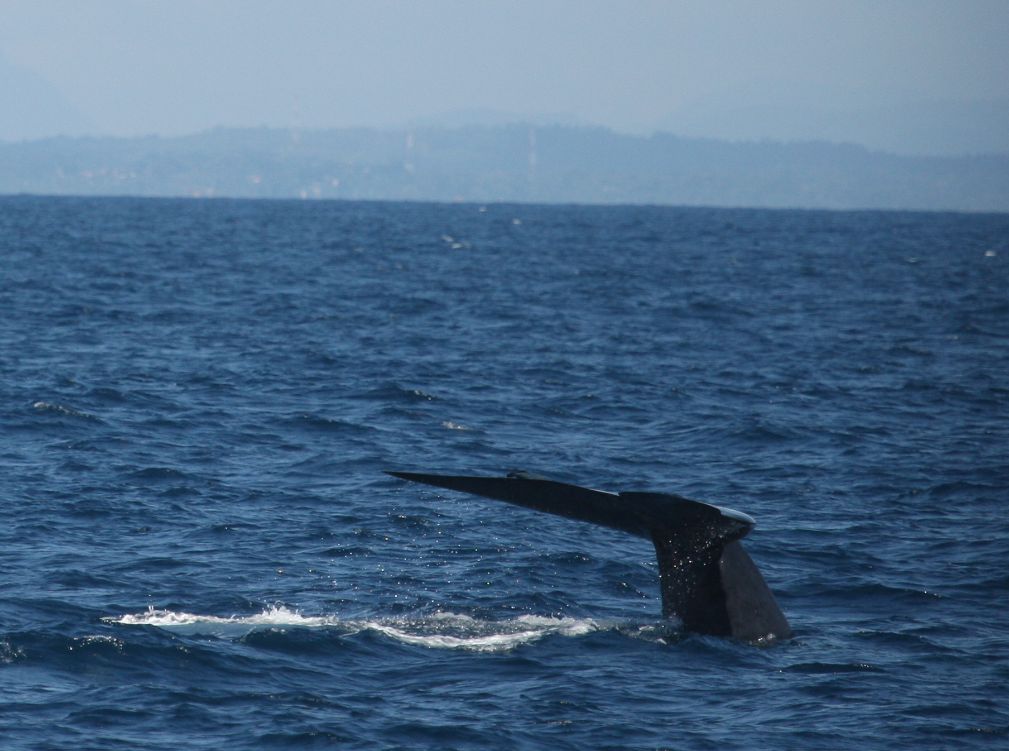
More lounging in our private pool followed and a stop the next day in Galle before heading back to the airport and home. The trip was fantastic and I would recommend going to anyone. We will definitely be going back for more.

Great post 😁
LikeLike
Looks like an amazing trip. Love the leopard and the mongoose. I don’t think I’ve ever seen a mongoose, even in a zoo.
LikeLike
Great post Gavin!
LikeLike